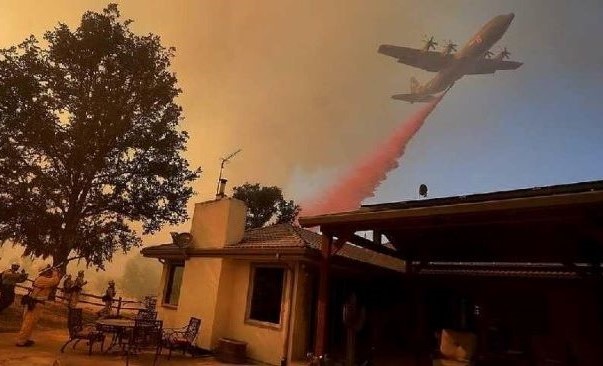 Fire retardant is dropped by airplane on a stretch of the devastating and deadly Carr Fire outside of Redding, Calif., during the summer of 2018. (Photo courtesy of U.S. National Guard)
Fire retardant is dropped by airplane on a stretch of the devastating and deadly Carr Fire outside of Redding, Calif., during the summer of 2018. (Photo courtesy of U.S. National Guard)Sophisticated computer tracking and mapping technology is the next line of defense in attacking wildfires that have become increasingly deadly and destructive in California and around the world, experts said at a conference Wednesday at Sacramento State.
But more firefighters on the ground, better forest management, improved alert systems and “hardening” of infrastructure also must play roles in controlling wildfires that now occur throughout the year in western states, said speakers at the Wildfire Technology Innovation Summit.
In California in 2017 and 2018, fires killed more than 100 people and destroyed thousands of homes. Wildfires burned 875,000 acres in the state last year. Global warming and drought have conspired to fuel extraordinarily intense fires that are exploding through forests and into urban areas, climate specialists say.
More than 700 people are attending the wildfire summit, which runs through Thursday. The conference brings together state and local government representatives, academics, utilities, industry specialists and others to brainstorm strategies for preventing and responding to fires.
“The turnout here today gives me hope that we’ll make progress,” said Michael Picker, president of the California Public Utilities Commission, which organized the conference.
Leonor Ehling, director of Sac State’s Center for California Studies, helped plan the event.
Ed Struzik, author of the bestselling book “Firestorm,” told the audience Wednesday that the fire landscape began dramatically changing in the early 2000s. Wildfires in the West erupted more frequently and behaved “in increasingly unpredictable ways,” in part because of the effects of climate change, he said.
California’s experience “is a harbinger of what is to come for the rest of the world,” Struzik said. Consequences could include devastating effects on oceans, sea life and wildlife, and air quality.
Struzik and others emphasized that public-policy officials, utilities, fire agencies and others must work together to find solutions to tame and effectively fight wildfires.
“This is a team sport,” said Thom Porter, director of the state Department of Forestry and Fire Protection.
“Our focus is on how we can help the tired, dirty, hungry firefighters who have been up for 36 hours to do their jobs better,” he said.
Improved technology is key, said Caroline Winn, chief operating officer for San Diego Gas and Electric.
San Diego has dramatically reduced fire risk and destruction by investing in a sophisticated weather monitoring network that includes mountaintop cameras providing “real-time information” about fire conditions. A daily “fire potential index” based on weather and other conditions goes to fire responders and is broadly shared, she said. These and other technological innovations have proved to be “game changers” for the city, Winn said.
San Diego also has “hardened” infrastructure in fire zones, including switching out wooden power poles for metal ones, she said. Despite protests from customers, it shuts off power during extreme weather conditions to reduce the risk of utility lines sparking fires.
Following devastating fires in 2003 and 2007, San Diego “turned tragedy into action,” Winn said.
“It became personal for all of us. Today, we are in a much better place,” she said. – Cynthia Hubert
